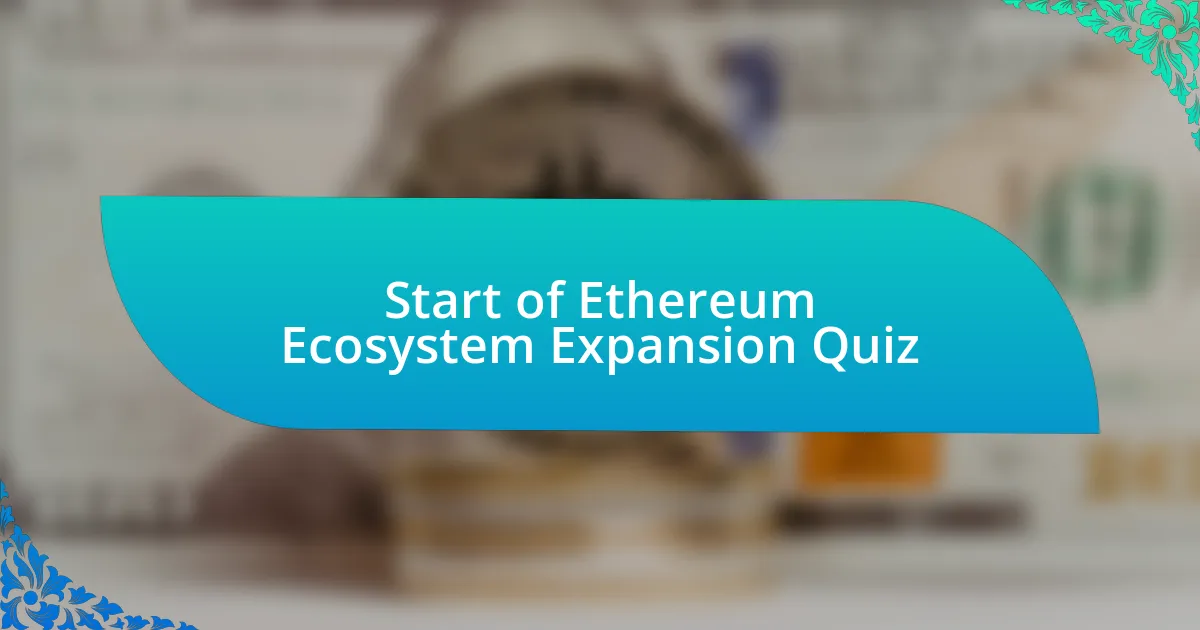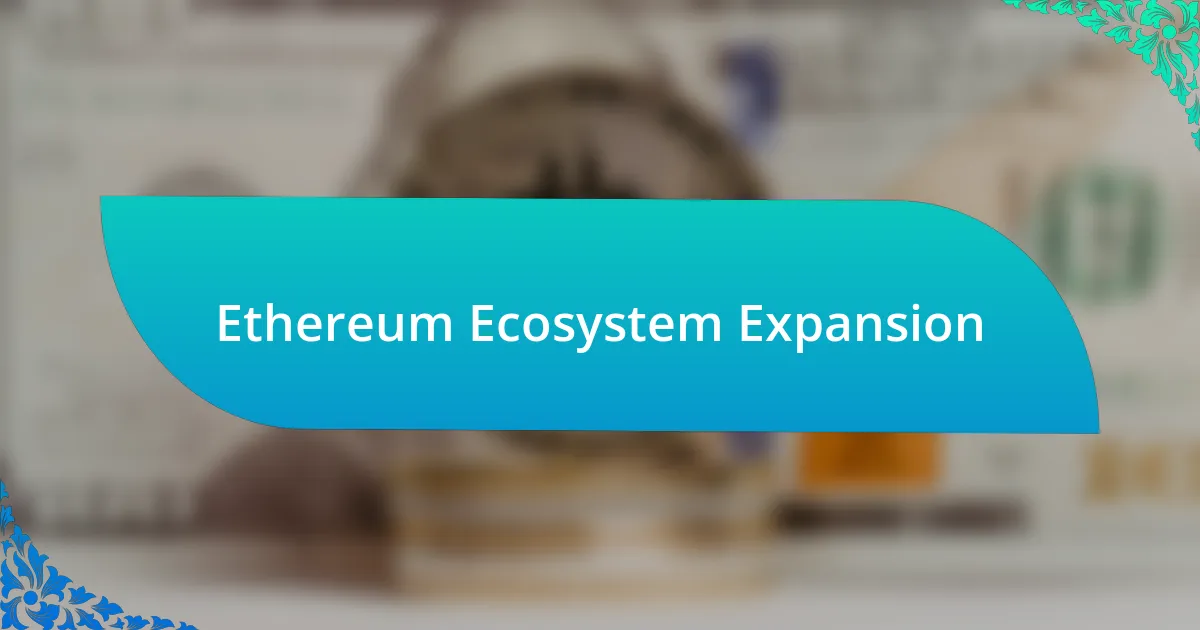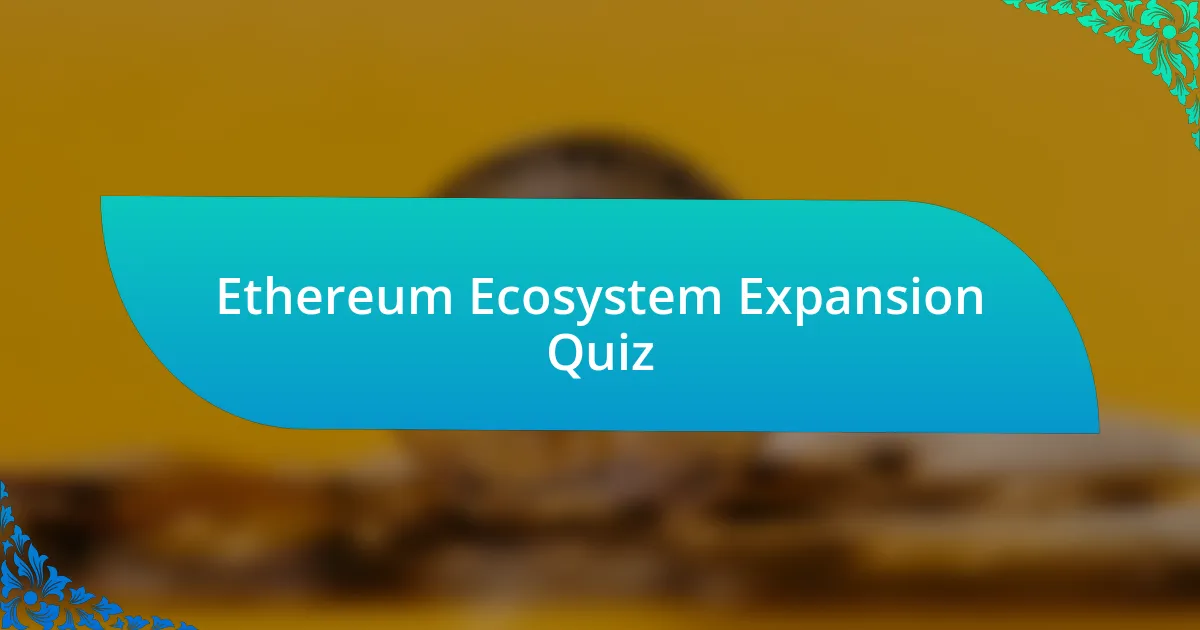
Start of Ethereum Ecosystem Expansion Quiz
1. Who are the original authors of Ethereum?
- Satoshi Nakamoto and Hal Finney.
- Jed McCaleb and Vitalik Buterin.
- Charles Hoskinson and Greg Maxwell.
- Vitalik Buterin and Gavin Wood.
2. What is the Ethereum Virtual Machine (EVM)?
- A digital wallet for storing Ether tokens.
- A centralized computer system for banking transactions.
- A decentralized virtual machine capable of handling scripts using the public nodes network.
- An internet browser for accessing Ethereum.
3. What is the value token for Ethereum?
- Bitcoin (BTC)
- Litecoin (LTC)
- Ether (ETH)
- Ripple (XRP)
4. What is Ether best defined as?
- A crypto-fuel(token) that powers the Ethereum network.
- A type of blockchain technology used in Bitcoin.
- A digital wallet for storing cryptocurrencies.
- A programming language for writing smart contracts.
5. What is the consensus algorithm used by Ethereum?
- Delegated Proof-of-Stake
- Practical Byzantine Fault Tolerance
- Proof-of-Stake
- Proof-of-Work
6. How does mining work in Ethereum?
- Ethereum mining is done manually by users without the need for any tools or wallets.
- Mining in Ethereum requires a specific hardware setup and does not need any software.
- Mining in Ethereum involves simply creating new tokens without any need for transactions.
- One needs to have a wallet and tools like Geth CLI to participate in the network and help add transactions to blocks.
7. What is a smart contract use case?
- It can track employee attendance in a workplace.
- It can be used in real estate to transfer property once the buyer transfers the property amount.
- It can automate payroll processes within a company.
- It can create an auction system for art sales.
8. What is MetaMask?
- A blockchain explorer for Ethereum transactions.
- A social media platform for sharing cryptocurrency news.
- A decentralized finance application for trading tokens.
- A popular browser-based Ethereum wallet used to interact with dApps on the Ethereum network.
9. What programming language is used to write smart contracts and dApps?
- Java
- C++
- Python
- Solidity
10. What is Truffle?
- A popular children`s game played outdoors.
- A testing and development environment for Ethereum that includes an asset pipeline.
- A type of gourmet cheese produced in France.
- A luxury chocolate made from rare fungi.
11. What is the block time in Ethereum?
- 60 seconds
- 30 seconds
- 14 seconds
- 10 seconds
12. Can transactions be kept hidden in the public Ethereum network?
- Transactions are private by default.
- Yes, all transactions can be hidden.
- Only large transactions can be concealed.
- No, all transactions are public.
13. Is the user’s private key used to sign transactions?
- It is used for balance checks.
- Yes.
- No.
- Only for encryption.
14. What is the functionality of Testnet?
- It allows developers to test applications without real Ether.
- It connects to the Bitcoin blockchain for interoperability.
- It verifies the authenticity of transactions on the main network.
- It increases transaction fees during high network traffic.
15. Do you need to use real Ether to test dApps and smart contracts?
- Yes, test networks require real Ether always.
- No, testing is only possible with actual Ether.
- No, free Ether can be used in test networks.
- Yes, only real Ether can be used for testing.
16. How does “spending” work in smart contracts?
- Spending does not require any fees to execute.
- Spending in smart contracts is free of charge.
- Any action that modifies the smart contract costs money (Gas).
- All actions in smart contracts are completed instantly.
17. What is Remix?
- A cryptocurrency trading platform.
- A mobile app for wallet management.
- A physical book on blockchain programming.
- An online tool for deploying, testing, and developing smart contracts.
18. How does Bitcoin differ from Ethereum in checking the latest state?
- Ethereum counts active nodes, while Bitcoin monitors transaction fees.
- Bitcoin tracks transaction history, while Ethereum checks user permissions.
- Bitcoin verifies account information, while Ethereum uses block confirmations.
- Ethereum checks account balance, while Bitcoin checks unspent transaction outputs (UTXO).
19. What happens when Gas runs out without the transaction being complete?
- The Gas is returned and the transaction resumes.
- All state changes are reversed, and used Ethereum Gas is given to the miner.
- The transaction is completed, and no fees are refunded.
- The user is charged extra fees for the incomplete transaction.
20. What is the market capitalization of Ethereum as of mid-2024?
- Approximately $220 billion
- Approximately $1 trillion
- Approximately $150 billion
- Approximately $500 billion
21. How many decentralized applications (dApps) are there on Ethereum as of mid-2024?
- 10,000
- Over 3,000
- 1,000
- 5,500
22. What are the major sectors in the Ethereum ecosystem?
- Manufacturing, retail, and agriculture.
- DeFi, NFTs, and enterprise solutions.
- Supply chain, gaming, and social media.
- Agriculture, mining, and transport.
23. What is the purpose of Ethereum 2.0?
- To eliminate all fees associated with transactions.
- To transition Ethereum from proof-of-work to proof-of-stake.
- To change the programming language used for smart contracts.
- To create a new cryptocurrency for storage solutions.
24. What are the key coins in the Ethereum ecosystem?
- Litecoin (LTC)
- Bitcoin (BTC)
- Ether (ETH)
- Ripple (XRP)
25. Why is Ethereum important for DeFi and NFTs?
- It centralizes control over digital identities and personal data.
- It creates only traditional forms of currency without innovation.
- It restricts access to financial markets for average users.
- It enables the creation and operation of decentralized finance applications and non-fungible tokens.
26. What are Layer 2 (L2) scaling solutions?
- Protocols that require all transactions to be verified on the main chain.
- Technologies designed to improve blockchain efficiency and performance without compromising security or decentralization.
- Methods that slow down transaction processing to enhance security.
- Tools for developing dApps that function apart from the blockchain.
27. How do L2 solutions work?
- They only work for NFT transactions and not for other types of transactions.
- They operate independently and do not connect to the main Ethereum network.
- They require all transactions to be processed on the main chain.
- They process transactions off-chain and then batch them together for settlement on the base layer.
28. What are the benefits of L2 solutions?
- Higher transaction throughput, reduced transaction costs, faster transaction finality, and improved privacy.
- Slower transaction speeds during peak times.
- Increased regulatory oversight and centralized control.
- Elimination of all transaction fees and total anonymity.
29. What are the limitations of L2 solutions?
- They eliminate the need for any on-chain transactions.
- They require participants to be online and are limited to pre-defined participant sets.
- They offer unlimited scalability without any costs.
- They are completely immune to security risks.
30. What is an example of an L2 solution?
- Blockchain forks
- Sidechains
- State channels
- Mainnets

Quiz Completed Successfully!
Congratulations on completing the quiz on the Ethereum Ecosystem Expansion! We hope you found the experience both enjoyable and informative. You may have gained insights into Ethereum’s growth, key projects, and its overall impact on the blockchain landscape. Understanding these elements is crucial as they shape how we interact with technology today.
This quiz has likely highlighted the unique features of Ethereum, such as smart contracts and decentralized applications. You may also have explored the role of community and innovation that drive Ethereum’s expansion. Each question was designed to deepen your knowledge and spark curiosity about this vibrant ecosystem.
We invite you to explore the next section on this page, where you can dive even deeper into the Ethereum Ecosystem Expansion. This additional resource will provide you with more detailed information and updates that can enhance your understanding. Keep the momentum going and continue your journey into the world of Ethereum!

Ethereum Ecosystem Expansion
The Evolution of Ethereum: A Brief Overview
The Ethereum network launched in 2015 as a decentralized platform enabling smart contracts and decentralized applications (dApps). It aimed to extend blockchain technology beyond cryptocurrency. Over the years, Ethereum has undergone significant upgrades, including Ethereum 2.0, enhancing scalability and security. This evolution directly supports the growing ecosystem, fostering innovation and attracting developers.
The Role of Decentralized Finance (DeFi) in the Ethereum Ecosystem
Decentralized Finance (DeFi) refers to financial services built on blockchain technology, eliminating intermediaries. DeFi has rapidly grown within the Ethereum ecosystem, offering lending, borrowing, and trading platforms. Protocols like Uniswap and Aave are popular examples, demonstrating Ethereum’s capability to facilitate complex financial operations directly on the blockchain.
NFTs and their Contribution to Ethereum’s Expansion
Non-fungible tokens (NFTs) are unique digital assets verified on the blockchain. Ethereum leads the NFT market, providing the infrastructure for platforms like OpenSea and Rarible. NFTs leverage Ethereum’s smart contract functionality to ensure ownership and provenance, boosting creative industries such as art and gaming. This sector’s boom has significantly contributed to Ethereum’s growth and visibility.
The Impact of Layer 2 Solutions on Ethereum Scalability
Layer 2 solutions enhance Ethereum’s transaction speed and reduce costs by processing transactions off the main blockchain. Technologies like Optimistic Rollups and zk-Rollups facilitate faster and cheaper transactions while still being secured by Ethereum’s main chain. These solutions are vital for accommodating increased network activity as the ecosystem expands, addressing congestion issues.
The Future of Ethereum: Merging with Web3 Technologies
The future of Ethereum lies in its integration with Web3 technologies, aiming to create a decentralized internet. Projects focusing on decentralized identity, privacy, and data ownership often leverage Ethereum. This merge attracts developers and users seeking alternatives to traditional web models. Web3 promises to enhance user autonomy, facilitating Ethereum’s position as a backbone of this new digital landscape.
What is Ethereum Ecosystem Expansion?
Ethereum Ecosystem Expansion refers to the growth and development of decentralized applications (dApps), protocols, and services built on the Ethereum blockchain. This encompasses advancements in DeFi (Decentralized Finance), NFTs (Non-Fungible Tokens), and new scaling solutions, such as Layer 2 networks, which enhance Ethereum’s capabilities. As of 2023, the Bitcoin and Ethereum ecosystems contain more than 4,000 unique dApps, showcasing significant expansion in both projects and user adoption.
How is Ethereum Ecosystem Expansion achieved?
Ethereum Ecosystem Expansion is achieved through technological upgrades, community initiatives, partnerships, and increased developer engagement. The Ethereum network benefits from updates like Ethereum 2.0, which shifts to proof of stake, enhancing scalability and security. Additionally, initiatives from organizations like the Ethereum Foundation fuel developer activity, driving innovation and attracting new projects to the ecosystem.
Where is the Ethereum Ecosystem primarily utilized?
The Ethereum Ecosystem is primarily utilized in various sectors, including finance, gaming, and digital art. Decentralized finance platforms enable users to lend, borrow, and trade cryptocurrencies. Gaming projects leverage NFTs for in-game assets. Marketplaces for digital art allow creators to sell their work as NFTs. In 2023, DeFi applications alone accounted for over $60 billion in total value locked (TVL), indicating widespread use across sectors.
When did Ethereum Ecosystem Expansion begin?
The Ethereum Ecosystem Expansion began with the launch of the Ethereum blockchain in July 2015. Since then, several key developments, including the introduction of smart contracts and the rise of DeFi in 2020, have significantly accelerated growth. Ethereum reached over 1,000 active projects by early 2020 and has continued to see exponential growth yearly.
Who are the main contributors to Ethereum Ecosystem Expansion?
The main contributors to Ethereum Ecosystem Expansion include developers, organizations, and the Ethereum community. Key players include the Ethereum Foundation, ConsenSys, and numerous independent developers who build protocols and dApps. These contributors drive innovation, facilitate funding, and enhance community engagement, actively propelling the ecosystem’s growth.

